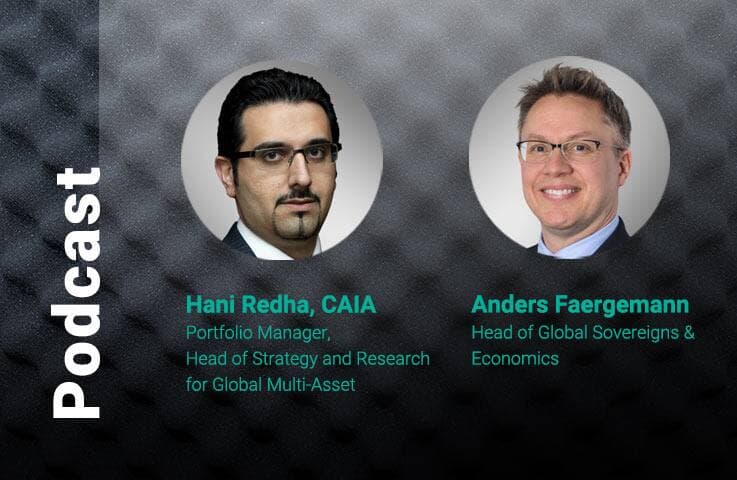Capital Market Line: From an Era of Insufficient Demand to One of Insufficient Supply

Michael J. Kelly, CFA
Global Head of Multi-Asset

Steven Lin, CFA
Portfolio Manager, Global Multi-Asset

Sunny Ng, CFA
Portfolio Manager, Global Multi-Asset

Mikhail Johaadien
Research Analyst, Global Multi-Asset

Hani Redha, CAIA
Portfolio Manager, Head of Strategy and Research for Global Multi-Asset

Peter Hu, CFA, FRM
Portfolio Manager, Global Multi-Asset

The decade leading up to the pandemic was characterized by insufficient demand, with central banks attempting to offset this by swelling their balance sheets and cutting interest rates to record lows. This “new abnormal” created much more financial leverage, inflating asset prices rather than creating demand. The global economy still struggled to crawl out of large and persistent output gaps while consumers were fixing their balance sheets. The latter was more of a one-off adjustment (even if it persisted for a decade) than a sign of secular stagnation.
Despite the slow cash flow growth that ensued, financial markets did quite well, propelled by increasingly generous capitalization rates courtesy of the central banks. At the same time, fiscal austerity was a drag on growth and required extreme largesse by central banks to offset it. The result was lackluster growth in the real economy paired with exceptional tailwinds for all financial assets.
This policy mix has now effectively reversed. After pulling the fiscal lever to combat the pandemic, politicians now sense that the fiscal shackles are off, while central bankers are scrambling to tighten financial conditions and withdraw excess liquidity at an unprecedented pace.
Modern Monetary Theory (MMT) was quietly put in place to battle the pandemic, with massive fiscal thrusts met almost dollar-for-dollar with equally massive central bank balance sheet surges. The latter prevented rates from rising to offset these fiscal thrusts, just as MMT prescribes. Yet contrary to its claims, MMT did indeed prove inflationary, and highly so when teamed with pandemic-related supply constraints. The impact is now wearing off, and with luck will not be seen again. Meanwhile, more structural impediments to supply appear to be settling in.
The pandemic coincided with further deglobalization and also helped spur it on. Russian President Vladimir Putin moved ahead on his long-held desire to reclaim former Soviet countries. Several factors may have spurred Putin to choose this moment, including the US withdrawal from Afghanistan and Germany’s push, for environmental reasons, to close down nuclear and coal plants much faster than it was bringing on new sources of solar and wind, leaving the country increasingly reliant on Russian gas. Energy shortages are set to be another lasting constraint on supply. Europe (including the UK) is at the epicenter of the problem, and it will take several years to build out the alternative energy infrastructure needed to replace Russian supply. This amounts to a persistent supply shock, and over our five-year investment horizon, we expect energy to be both a seasonal drag on growth and a driver of higher baseline inflation.
Yet the invasion of Ukraine backfired on Putin by accelerating the erection of what some are calling a new Berlin Wall. The fall of the Berlin Wall in 1989 freed up companies with international ambitions to tap world markets, bringing with them supply-side competition. This in turn unleashed productivity and disinflation, allowing others to compete, and in time stepped-up growth. After the invasion of Ukraine, multinationals needed to walk away from lengthy and sizable investments in Russia. Now, instead, Europe is accelerating its decarbonization plans to reduce reliance on Russian energy, with Germany bringing forward its net-zero plans by 15 years. Renewable energy is now a matter of national security as well as climate change. This should lead to a sizable rise in investment at a global level, creating an important tailwind for growth and job creation over our forecast horizon, particularly in years three to five; the annual investment gap to meet net zero is estimated at over $2 trillion.1
Another accelerant is China’s 2021 policy crackdowns on a number of private industries, which, paired with President Xi’s cautious embrace of Putin, has multinationals questioning whether they should continue investing as heavily in China. Just as Covid-related supply-chain bottlenecks are mending, these new more structural supply-side rigidities are solidifying. China’s growth is slowing predominantly due to declining private sector incentives and investment. For large swaths of the global economy that have relied on Chinese demand (e.g., European exporters and select emerging markets), the next few years will be particularly challenging. For commodity exporters, all else equal, the impact of China’s move away from an investment-led, quantity-of-growth model will be negative.
The pandemic has also changed attitudes about work/life balance, and while the jury is still out on the impact of this shift, it has thus far coincided with a drop in GDP-based productivity metrics. Labor force participation rates are not recovering without much greater compensation and flexibility to pull workers back in. This could be the best of all worlds if it were met by rising productivity, yet it continues to fall. Participation rates have also been impacted by a shortfall of millions of workers due to constrained immigration, persistent pandemic-related health issues, and an acceleration in retirements. There are good reasons to expect these factors to persist for some time.
ESG 1.0 – the era of excluding whole “problem” industries from investment – is coming under scrutiny amid structural shortages in many basic commodities, including food and the “green metals” needed to run the turbines that will pave the way for solar and wind. The oil crisis is not all about Putin’s invasion; it began with lower reinvestment in prior years. Yet ESG 2.0, marked by a willingness to invest in formerly excluded industries if companies are committed to becoming more carbon-efficient or making other “green” improvements, may be a more reasonable path forward that will likely gain ground.
Despite these headwinds, inflation may yet trend down, but to facilitate that, the overdose of central bank liquidity that was so pivotal to the past decade’s return tailwinds must be replaced by a more disciplined approach. And the new cycle is indeed shaping up to be remarkably different, and not only on the supply side. Demand is robust as well, as a result of healthier private sector balance sheets. In contrast to the post-financial-crisis paydown of accumulated debt, today’s excess savings nurture a more solid demand outlook. Beyond an imminent dip as central bank tightening begets lower demand over the next year, the period beyond appears to offer several years of robust private-sector demand.
All told, the new regime is characterized by robust demand and constrained supply, combined with a looser fiscal posture and tighter monetary backdrop. This is resulting in elevated macro volatility. Despite this year’s selloff in markets, our Capital Market Line is not particularly steep. The withdrawal of liquidity after a long deluge has brought valuations from very high to reasonable, but not depressed, prices. Despite market declines, today’s prices still do not represent a launching pad for above-average returns over the next five years.
Capital Market Line as of 30 September 2022 (Local Currency)

Capital Market Line as of 30 September 2022 (USD View, Unhedged)

Please see Capital Market Line Endnotes. Note that the CML’s shape and positioning were determined based on the larger categories and do not reflect the subset categories of select asset classes, which are shown relative to other asset classes only.
Insights From Today’s CML
A flattening Capital Market Line (CML) with a high level of dispersion. The slope of our CML has improved amid falling prices, yet not significantly, as we continue to incorporate the impact of the new macro regime on our fundamental forecasts. The withdrawal of liquidity will be a particularly challenging headwind for financial asset valuations. Equities are no longer the most attractive asset class. Pockets of extreme over- and under-valuation are less prevalent.
Developed market (DM) government bonds are becoming more attractive. With yields rising to levels not seen in a decade, the standalone value of DM government bonds has improved significantly. At the same time, the regime ahead will feature less negative stock-bond correlations.
Credit assets have become more attractive relative to equities. Credit spreads have widened more than equity risk premia, although neither appear to be pricing in a recession. Yet for buy-and-hold investors over the next five years, market declines this year along with higher yields have made credit assets more attractive given their lower risk than many equity markets. This is in stark contrast with the previous cycle, when credit spreads were stapled to the floor. US high yield stands out in this regard, supported by much better credit quality and lower default risk. Asian investment-grade bonds also appear attractive, having widened in sympathy with broader credit markets while maintaining one of the most robust fundamental profiles.
Equities contend with less-generous capitalization rates but benefit from higher nominal cash flows. The policy mix of the new cycle will support higher nominal cash flows as excess capacity is absorbed and a healthy private sector ramps up spending. The main challenge to equities is a higher risk premium as excess liquidity is mopped up, making capitalization rates less generous. This repricing drag offsets the contribution of growth to returns. Our ongoing lukewarm outlook for emerging market (EM) growth, dragged down by China and deglobalization trends, leaves EM equities looking relatively unattractive despite recent underperformance. Commodity producers within EM may be an exception, but ESG considerations mean that a highly selective approach is needed to access this slice.
Commodity prices already reflect the demand boost. Higher military and decarbonization spending, along with the rebuilding of energy infrastructure in Europe, is adding incremental demand for commodities in the years ahead. This new spending may offset slowing demand growth from China, the single largest consumer of commodities. Much of this incremental demand is likely already reflected in the sharp rise in commodity prices year-to-date, though we see commodity prices well supported by a lack of growth in supply as global producers remain disciplined about adding capacity.
The Fundamentals Driving Our CML
From demand deficiency to supply scarcity. Recent supply constraints in labor, energy, and capacity appear to be more structural than transitory, in contrast to the last cycle. Demand, on the other hand, remains robust even in the face of fiscal drags and tighter financial conditions. This combination will induce ongoing withdrawal of excess liquidity, challenging most financial assets.
Energy supply reemerges as a strategic imperative in a politically polarized world. Russia’s invasion of Ukraine has triggered an energy supply crisis after a quiet geopolitical period that had lulled politicians into taking energy supply for granted. The drive to combat climate change was also mismanaged, leading to overreliance on less-reliable renewable energy sources, exacerbating the problem. We expect the rebuilding of energy networks to take several years, with Europe incurring substantially higher energy costs across its economy. Profitability will be challenged, with the weaker currency only partially offsetting global competition.
A reflationary and more volatile macro regime takes hold. The previous cycle featured below-target inflation and extraordinary monetary policy settings designed to reflate the economy and achieve target inflation. Liquidity gushed in, dampening macro volatility. The current cycle will feature mostly above-target inflation, and monetary policy will have to walk the tightrope of tightening conditions enough to bring inflation down to target but not enough to cause a recession. Such regimes are inherently more volatile. The result may be shorter cycles that reset macro conditions via short and shallow recessions.
Acceleration of decarbonization. For Europe, decarbonization has become as much a matter of national security as a climate change imperative. Europe is set to accelerate its decarbonization plans to reduce its reliance on Russian energy, with Germany bringing forward its net-zero plans by 15 years. This should lead to a sizable rise in investment at a global level and provide an important tailwind for growth and job creation over our forecast horizon, particularly in years three to five; the annual investment gap to meet net zero is over $2 trillion.2 That said, recent spikes in energy prices show how difficult it is to assess and manage the knock-on effects of these policies, and commodity prices may set the “speed limit” of these initiatives. Higher macro volatility may be part of the cost.
Reshoring and the restructuring of supply chains. Growing evidence shows that firms are adopting a “China plus one” strategy to diversify their supply chains, with India as a key beneficiary. The combination of the US-China trade war and the Covid pandemic cemented the need for companies to restructure their supply chains to avoid costly disruptions. Companies will be willing to pay a premium to secure supplies in a less globalized world. This will require substantial investment and will leave the system less efficient than in the last few cycles. Regionalization will be less supportive of EM economies overall, and decisions will be more forcefully influenced by political alignment. India and a handful of other EMs will be the few exceptions that benefit from this shift.
China pivots to strategic priorities beyond economic growth. This critical political year in China will likely cement its pivot toward “common prosperity” and a strategic focus on sustainable and inclusive growth, with more centralized control. The real estate market, as the biggest driver of China’s growth and the greatest burden among the “three mountains” of housing, education, and health care, is in the crosshairs of this strategic shift. Policymakers will fine-tune fiscal and monetary policy to avoid disruption, yet the impact on growth will likely be felt globally. In parallel, the pace of changing regulations across several sectors has already dented private sector confidence. The gains for China in the long run may be more sustainable growth and more equitable distribution of wealth. Yet the transition is likely to involve upheaval and volatility. China’s political decisions on the global stage will be key. We expect China to avoid outright confrontations but to be increasingly assertive in charting its path forward.
Capital Market Line Endnotes
The Capital Market Line (CML) is based on PineBridge Investments’ estimates of forward-looking five-year returns and standard deviation. It is not intended to represent the return prospects of any PineBridge products, only the attractiveness of asset class indexes, compared across the capital markets. The CML quantifies several key fundamental judgments made by the Global Multi-Asset Team for each asset class, which, when combined with current pricing, results in our annualized return forecasts for each class over the next five years. The expected return for each asset class, together with our view of the risk for each asset class as defined by volatility, forms our CML. Certain statements contained herein may constitute “projections,” “forecasts,” and other “forward-looking statements” which do not reflect actual results and are based primarily upon applying a set of assumptions to certain financial information. Any opinions, projections, forecasts, and forward-looking statements presented herein are valid only as of the date of this document and are subject to change. There can be no assurance that the expected returns will be achieved over any particular time horizon. Any views represent the opinion of the investment manager and are subject to change. For illustrative purposes only. We are not soliciting or recommending any action based on this material.
About the Capital Market Line
The Capital Market Line (CML) is a tool developed and maintained by the Global Multi-Asset Team. It has served as the team’s key decision support tool in the management of our multi-asset products. In recent years, it has also been introduced to provide a common language for discussion across asset classes as part of our Investment Strategy Insights meeting. It is not intended to represent the return prospects of any PineBridge products, only the attractiveness of asset class indexes compared across the capital markets.
The CML quantifies several key fundamental judgments made by the Global Multi-Asset Team after dialogue with the specialists across the asset classes. We believe that top-down judgments regarding the fundamentals will be the largest determinants of returns over time driving the CML construction. While top-down judgments are the responsibility of the Multi-Asset Team, these judgments are influenced by the interactions and debates with our bottom-up asset class specialists, thus benefiting from PineBridge’s multi-asset class, multi-geographic platform. The models themselves are intentionally simple to focus attention and facilitate a transparent and inclusive debate on the key drivers for each asset class. These discussions result in 19 interviews focused on determining five year forecasts for over 100 fundamental metrics. When modelled and combined with current pricing, this results in our annualized expected return forecast for each asset class over the next five years. The expected return for each asset class, together with our view of forward-looking risk for each asset class as defined by volatility, forms our CML.
The slope of the CML indicates the risk/return profile of the capital markets based on how the five-year view is currently priced. In most instances, the CML slopes upward and to the right, indicating a positive expected relationship between return and risk. However, our CML has, at times, become inverted (as it did in 2007), sloping downward from the upper left to the lower right, indicating risk-seeking capital markets that were not adequately compensating investors for risk. We believe that the asset classes that lie near the line are close to fair value. Asset classes well above the line are deemed attractive (over an intermediate-term perspective) and those well below the line are deemed unattractive.
We have been utilizing this approach for over a decade and have learned that, if our judgments are reasonably accurate, asset classes will converge most of the way toward fair value in much sooner than five years. Usually, most of this convergence happens over one to three years. This matches up well with our preferred intermediate-term perspective in making multi-asset decisions.
Disclosure
Investing involves risk, including possible loss of principal. The information presented herein is for illustrative purposes only and should not be considered reflective of any particular security, strategy, or investment product. It represents a general assessment of the markets at a specific time and is not a guarantee of future performance results or market movement. This material does not constitute investment, financial, legal, tax, or other advice; investment research or a product of any research department; an offer to sell, or the solicitation of an offer to purchase any security or interest in a fund; or a recommendation for any investment product or strategy. PineBridge Investments is not soliciting or recommending any action based on information in this document. Any opinions, projections, or forward-looking statements expressed herein are solely those of the author, may differ from the views or opinions expressed by other areas of PineBridge Investments, and are only for general informational purposes as of the date indicated. Views may be based on third-party data that has not been independently verified. PineBridge Investments does not approve of or endorse any republication of this material. You are solely responsible for deciding whether any investment product or strategy is appropriate for you based upon your investment goals, financial situation and tolerance for risk.



